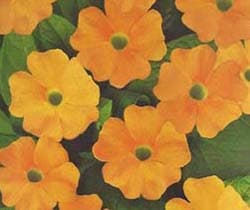How to Grow Thunbergia Flowers, Black-Eyed Susan Vine

About Growing Thunbergia in Your Home Flower Garden
You’re going to love growing Thunbergia vines. Also called Black-Eyed Susan vines, they are native to Eastern Africa. This climber has become naturalized all over the world. It produces an attractive, profusion of daisy-like flowers. Thunbergia flower colors include colors of orange, pale yellow, and white.
While Thunbergia is also called Black-Eyed Susan Vine, it is not even in the same family as the Black-Eyed Susan that we know of as a bush plant, which is Rudbeckia Hirta. These are entirely different plants, with entirely different growth habits.
Thunbergia will look great on a fence, a trellis, mailbox posts, lampposts, or in a hanging container. You can also grow it in a container and let it hang down from your balcony or deck.
Some flower gardeners allow Black-Eyed Susan vines to sprawl and grow directly on the ground as a ground cover.
Flowers Bloom: Summer through Fall
Other Names: Clock Vine
Plant Height: As an annual, vines can grow up to 8 feet. In frost-free areas, it can be grown as a perennial and reach up to 20′.
Thunbergia Alata, Half Hardy Annual
Annual Thunbergia Flowe Plant Propagation
Thunbergia vines are grown from seed. Black-Eyed Susan seeds can be directly seeded into your flower garden, after the last frost in your area. Or, start them indoors 6-8 weeks before the last frost date.
For indoor starts, we recommend using peat pots, as the plants do not like to have their roots disturbed.
Seeds take a long time to germinate. When planting seeds directly into your garden, mark the area where you plant them.
Thunbergia can be propagated by cuttings. Take a 6 to 8-inch stem from a tender, growing tip, and root it in water.
You can also propagate Thunbergia vines by “layering”. Take a low-growing vine, and bend it carefully to the ground. At about 8 inches from the end of the vine, cover the vine with soil. Stake the vine down, so the wind will not pull it up. Keep the area that is in contact with the soil well-watered. A few weeks later, it will have formed roots. Cut the vine just before the root, and replant your new Thunbergia plant.
Days to Germinate: 10 – 25
Garden Tip: Soak seeds in water overnight
How to Grow Thunbergia Flower Plants
Thunbergia Vines are very easy to grow.
Grow the plants in full sun to light shade. In hotter regions, plant them where they will receive afternoon shade.
Grow Thunbergia in rich soils to help fuel growth. Before planting, mix in ample amounts of compost. Add a general-purpose fertilizer every 4-6 weeks.
Thunbergia plants do not tolerate droughts very well. Keep the soil well-watered, especially when young, and during hot and dry weather. If grown in containers, be vigilant that they do not dry out.
Keep young plants well weeded, until they get established and begin to climb.
Thunbergia plants can be trimmed, as needed.
Plants need the support of a fence, trellis, or post. Train young plants to reach the support.
Ideal Soil pH: Slightly acidic
Insects and Plant Disease
Thunbergia seldom have problems with insects and disease. White flies and spider mites can infest the plants. Treat with insecticidal soap, if needed.
Related Articles
Also, people who read this article will like:
Black-Eyed Susan Plant – Rudbeckia Hirta, the bush variety.
Plant Problems – Identify the causes and find the cures.
Please support our site. Shop for:
- rmmatthews100@hotmail.com
- 585-721-6528
- Rochester, NY
©1999-2024 GardenersNet.Com, All Rights Reserved

